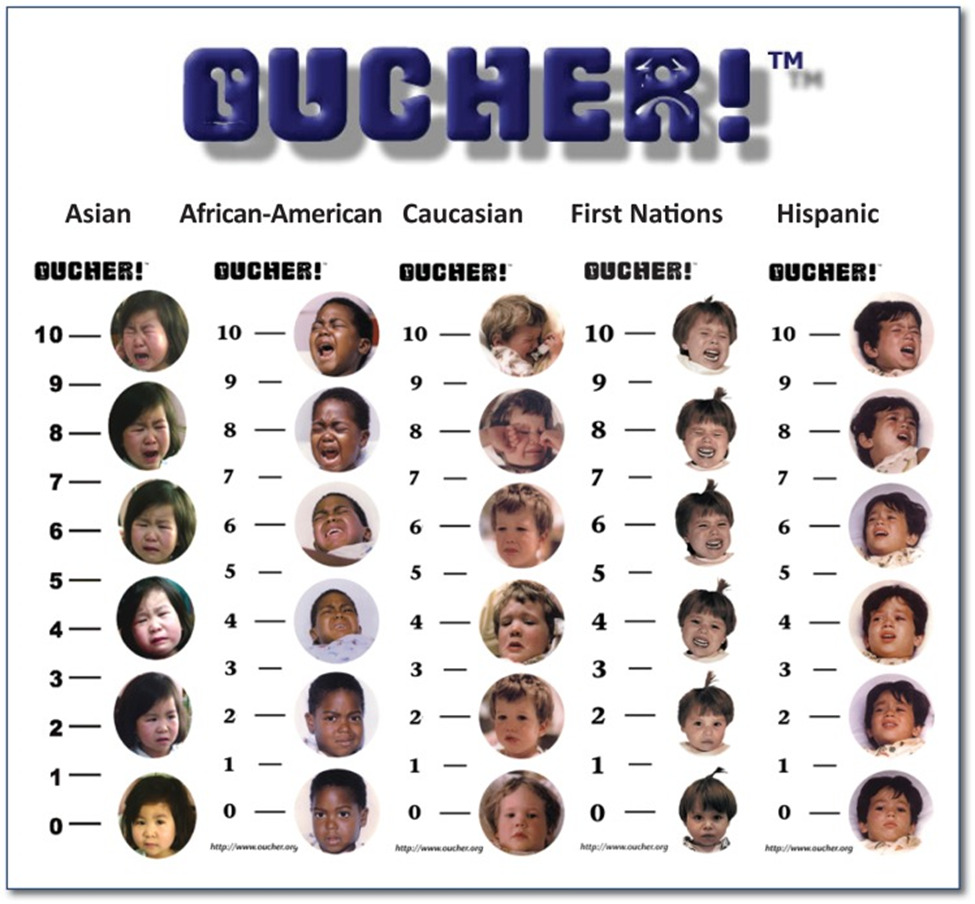A nurse is assessing a 4-year-old child following a surgical procedure. Which of the following pain rating scales should the nurse use?
Oucher pain rating scale
Word-Graphic rating scale
Numeric rating scale
Visual analog scale
The Correct Answer is A
A. Oucher pain rating scale: The Oucher pain rating scale uses pictures of children's faces to represent varying degrees of pain intensity. This scale is specifically designed for young children and can be effective in assessing pain in preschool-aged children who may not yet be able to accurately use verbal descriptors to express their pain.
B. Word-Graphic rating scale: This type of scale presents both words and pictures to represent different levels of pain intensity. While it may be suitable for older children who can understand and use words to describe their pain, it may be less effective for a 4-year-old child who is still developing language skills.
C. Numeric rating scale: Numeric rating scales typically ask the child to rate their pain on a scale from 0 to 10, with 0 representing no pain and 10 representing the worst pain imaginable. While this scale may be appropriate for older children, it may be challenging for a 4-year-old to understand and use numbers to describe their pain.
D. Visual analog scale: Visual analog scales typically consist of a line with endpoints labeled "no pain" and "worst pain imaginable," with the child asked to mark or point to the spot on the line that represents their pain level. While this scale may be suitable for older children and adults, it may be too abstract for a 4-year-old child to understand and use effectively.

Nursing Test Bank
Naxlex Comprehensive Predictor Exams
Related Questions
Correct Answer is C
Explanation
A. "Monitor your child for excessive sleepiness."
Methylphenidate is a central nervous system stimulant used to treat attention deficit hyperactivity disorder (ADHD). It typically causes insomnia or decreased need for sleep rather than excessive sleepiness. This option is incorrect, as it does not align with the expected side effects of the medication.
B. "Administer the medication with a caffeinated beverage."
Caffeine is also a stimulant, and combining it with methylphenidate could increase the risk of side effects such as increased heart rate, anxiety, or jitteriness. This instruction is incorrect and unsafe.
C. "Administer the second dose of the medication at lunch time."
Methylphenidate is usually given in divided doses, with the second dose often administered at lunchtime. This timing helps maintain therapeutic levels during the school day while minimizing the risk of insomnia. This option is correct and appropriate for managing the medication.
D. "Monitor your child for weight gain."
A common side effect of methylphenidate is appetite suppression, which can lead to weight loss, not weight gain. This option is incorrect, as the nurse should instruct the parent to monitor for weight loss instead.
Correct Answer is A
Explanation
A. Report of diplopia
Diplopia, or double vision, can be a symptom of increased intracranial pressure (ICP) due to its effects on cranial nerve function. Therefore, it is a manifestation that the nurse should recognize as indicating the presence of increased ICP.
B. Hyperactivity
Hyperactivity is not typically associated with increased ICP. Instead, manifestations of increased ICP often include altered level of consciousness, lethargy, or even coma.
C. Nuchal rigidity
Nuchal rigidity, or stiffness in the neck, is not a direct manifestation of increased ICP. It is more commonly associated with meningitis or other conditions affecting the meninges.
D. Report of sore throat
A sore throat is not typically associated with increased ICP unless it is related to complications such as pharyngeal injury or infection.
Whether you are a student looking to ace your exams or a practicing nurse seeking to enhance your expertise , our nursing education contents will empower you with the confidence and competence to make a difference in the lives of patients and become a respected leader in the healthcare field.
Visit Naxlex, invest in your future and unlock endless possibilities with our unparalleled nursing education contents today
Report Wrong Answer on the Current Question
Do you disagree with the answer? If yes, what is your expected answer? Explain.
Kindly be descriptive with the issue you are facing.
